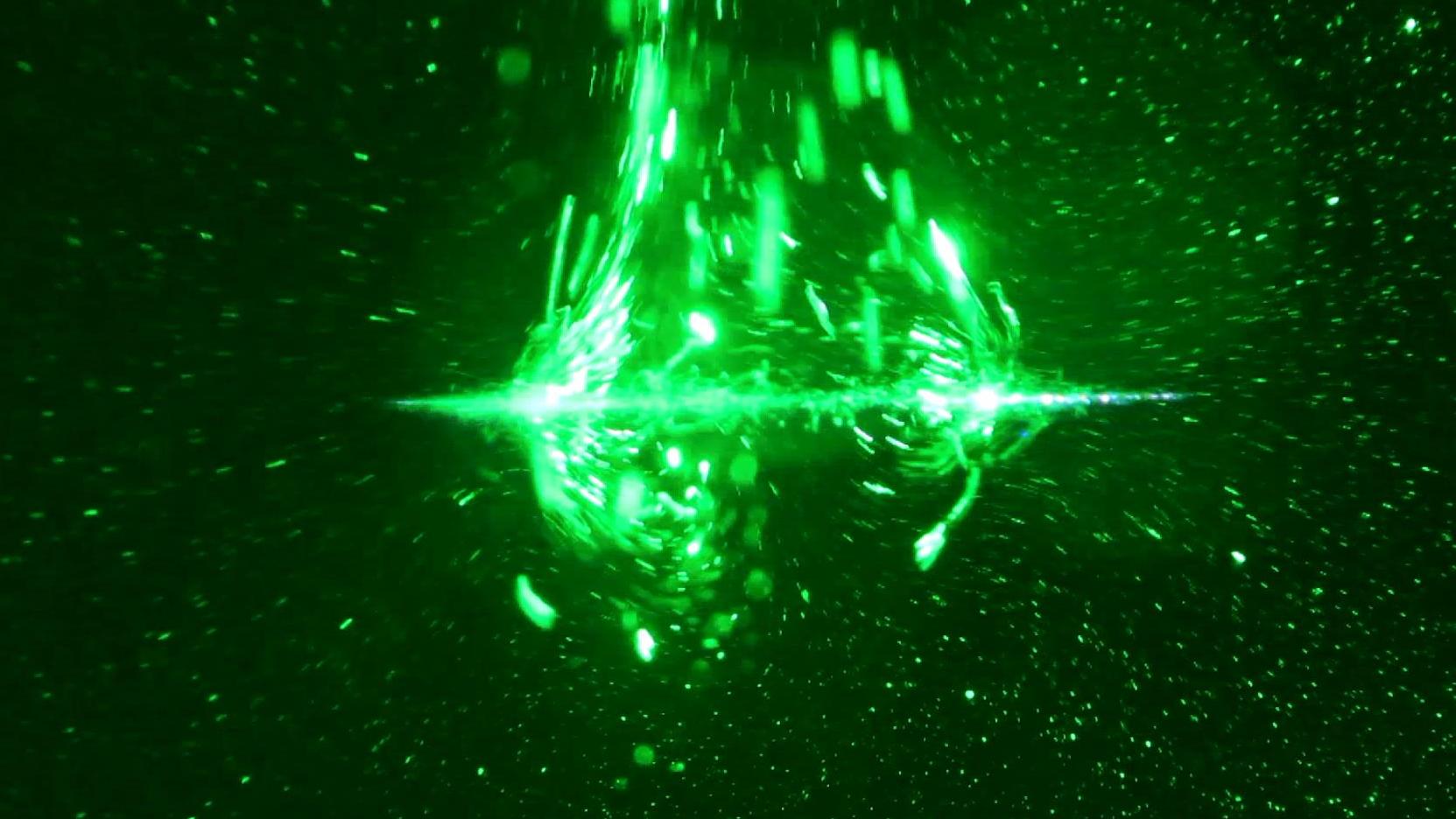
The paper is devoted to generation and observing quasi-stationary flows under the effect of the focused periodic-pulse femtosecond laser radiation on liquid solvents: water, heavy water, alcohols, ketones, chlormetanes. The mechanism inducing directional flow appears to be directional collapse of the gas bubbles produced by multiphoton dissociation in a focused laser beam. Formation of the flows had being observed by schlieren technique and by framing small gas bubbles illuminated by visible laser beam converted to the line. Absorption coefficients of focused and unfocused laser radiation in the fluids were also measured in the experiments.
In experiments with laser pulses of 450 fs at 1.023 nm wavelength with pulse energy from 10 to 220 uJ and repetition rate 1.43-10 kHz stationary flows of fluids were originated from the laser beam waist directed along or transversely (in most cases) to the laser beam. The streams along the laser axis in both directions were observed under low pulse power (10-22 uJ) provided precise lens adjustment without astigmatism or self-focusing. The tests show that single beam waist generates two narrow jets along the beam axis in both directions from interaction point. Lens displacement transversely to the beam leads to splitting beam waist in two astigmatic foci. Both foci generate oncoming axial flows colliding in the gap between foci, forming synthetic flow directed transversely to the laser beam.
The increase of the pulse energy and focal point intensity is followed by nonlinear self-focusing forming filament like beam waist several millimeter long. Repeating cycles of self-focusing and defocusing produce several energy deposition zones along the filament beam waist, each one generating separate axially directed streams. Interactions of the colliding axial streams produce rather complex flow pattern along ant transversely to the laser beam axis.
laser-induced flows in liquids, femtosecond laser, laser beam self-focusing, multiphoton dissociation, laser beam interaction with liquids, laser processing

Данная работа посвящена получению и наблюдению квазистационарных потоков при воздействии сфокусированного импульсно-периодического излучения фемтосекундного импульсно-периодического лазера на жидкие растворители: воду, спирты, кетоны, хлорметаны. Вероятная причина образования стационарного потока – направленный коллапс газовых пузырьков, образующихся под действием лазерного излучения в результате многофотонной диссоциации. Образование потоков наблюдалось теневым методом, а также путем лазерной подсветки газовых пузырьков субмиллиметрового размера. В экспериментах измерялись коэффициенты поглощения сфокусированного и несфокусированного излучения фемтосекундного лазера в исследуемых жидкостях.
В экспериментах с импульсами длительностью 450 фс, длиной волны 1.023 мкм при энергии в импульсе от 10 до 220 мкДж и частоте повторения 1.43-10 кГц возникали стационарные потоки из области фокальной перетяжки вдоль оси лазерного луча, а также в перпендикулярном направлении.
Поток вдоль оси луча в обоих направлениях наблюдался при малой энергии в импульсе (10-20 мкДж) при условии точной настройки линзы, гарантирующей отсутствие астигматизма. В экспериментах в отсутствие астигматизма и самофокусировки в отдельной фокальной перетяжке диаметром 10-20 мкм и длиной 100-200 мкм формировался поток в виде двух узких струй вдоль оси луча в обе стороны от точки взаимодействия. Смещение фокусирующей линзы в поперечном направлении относительно оси луча ведет к появлению двух астигматических фокусов, при достаточном расстоянии между которыми генерируются встречные осевые потоки, которые, сталкиваясь, растекаются в стороны, образуя синтетический поток в направлении, перпендикулярном лазерному лучу
При увеличении энергии в импульсе и интенсивности излучения в области фокуса усиливается эффект нелинейной самофокусировки и образуется самоограниченный участок луча в виде тонкой перетяжки длиной несколько миллиметров. Вследствие повторяющегося процесса самофокусировки и дефокусировки на протяжении перетяжки возникает несколько областей высокой интенсивности, каждая из которых генерирует осевые потоки, как отдельная перетяжка в экспериментах с малой энергией в импульсе. Взаимодействие генерируемых осевых потоков порождает сложную картину течений вдоль и поперек оси лазерного луча.
лазерно-индуцированные потоки в жидкостях, самофокусировка, многофотонная диссоциация, фемтосекундный лазер, лазерные технологии
На видео потоки жидкости вокруг филамента в сфокусированном луче импульсно-периодического фемтосекундного лазера в тяжелой воде (99.9% D2O) визуализированы пузырьками продуктов диссоциации жидкости, подсвеченными сверху излучением лазера с длиной волны 532 нм, развернутым в "световой лист". Излучение фемтосекундного лазера (длина волны 1023 нм, частота следования импульсов 3.3 кГц, энергия в импульсе на входе в филамент 107 мкДж, длительность импульса 450 фс) подводится слева направо. Параметр фокусировки f/17. Режим течения установившийся, скорость съемки 23 кадра в секунду.